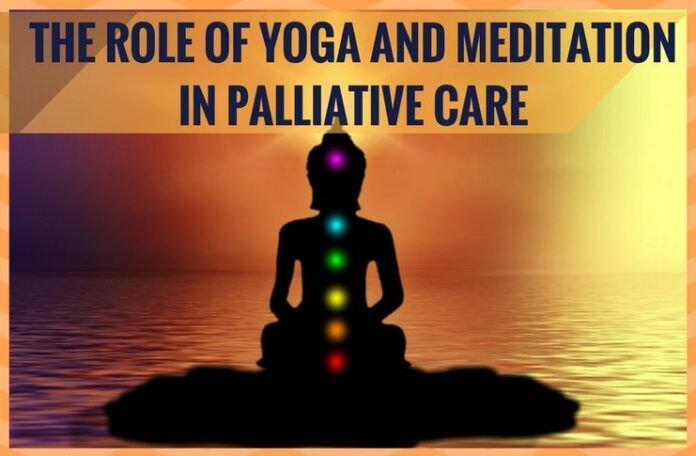
Meditation and yoga can improve quality of life in Palliative care
[dropcap color=”#008040″ boxed=”yes” boxed_radius=”8px” class=”” id=””]N[/dropcap]ever the spirit was born; the spirit shall cease to be never; never was the time it was not; End and Beginning are dreams! Birthless and deathless and changeless remaineth the spirit forever; Death hath not touched it at all, dead though the house of it seems. ‘ Bhagwat Gita,’ Chpt 2, verse 20
Meditation is one of the most ancient practices devised by sages in the Hindu traditions from times unknown.
Medical systems in America confront a significant population of patients belonging to the Hindu religious community in their routine practices. The newly released 2016 Yoga in America study, conducted by Yoga Journal and Yoga Alliance, shows that the number of US yoga practitioners has increased to more than 36 million, up from 20.4 million in 2012. These practitioners, however, do not necessarily practice Hinduism, but rather the non-sectarian practice of yoga and meditation. Thus, it is essential that doctors and medical practitioners must have some insights into the foundational knowledge about the philosophical perspectives and spiritual dimensions associated with yoga and meditation.
[dropcap color=”#008040″ boxed=”yes” boxed_radius=”8px” class=”” id=””]I[/dropcap]n the Indian, especially Hindu traditions, health goes beyond a mere absence of disease. It is a way of disease-free living, healing and coping with the outcomes of many conditions of life in a way which may seem for most of us to be incomprehensible. Physical wellbeing now encompasses not only biological wellbeing but also the psychological, social and spiritual dimensions of health care. The pursuit of health should continue even in situations where a person receiving treatment for his existing condition fails to respond. It is of prime importance to keep a patient motivated, psychologically nourished and spiritually nurtured in order to come to terms with an unsure physical future and cope with not only the physical trauma of pain but also mental stress.
World Health Organization (WHO) defines Palliative care as an approach that improves the quality of life of patients and their families facing the problem associated with life-threatening illness, through the prevention and relief of suffering by means of early identification and impeccable assessment and treatment of pain and other problems, physical, psychosocial and spiritual.
[dropcap color=”#008040″ boxed=”yes” boxed_radius=”8px” class=”” id=””]P[/dropcap]alliative care is a speciality care devised by the medical fraternity to care for individuals facing potentially fatal diseases since these are associated with severe anxiety and depression, along with the acute pain and physical symptoms of the disease. It is a system constructed to cater to the psychosomatic wellbeing of an individual who suffers from an ongoing deteriorating health condition and faces very scanty chances of progress and potential survival.
In the recent history of physical care practices, within the wide range of coping techniques recommended for palliative care, the most widely used and popularly practiced techniques belong to the field of spirituality.
People under palliative care are extremely vulnerable to contemplation’s on the ruminating thoughts of a prolonged period of pain associated with anxieties about the question of the future of their families and possessions after their death, the physical challenges of their own mobility after the condition reaches a final stage of culmination and their aesthetic appearances after an invasive treatment (women thinking about hair loss from chemotherapy or breast mastectomy) to name a few. It is a state which brings sadness, debilitation and fatigue. In such cases, the best approach is to provide a perspective of compassion towards one’s self and cultivate a spirit of enthusiasm towards the possibilities of making the most out of the days one spends in survival. The ruminating thoughts about one’s degenerating health can be reduced and replaced by cultivating techniques of meditation and yogic wisdom.
[dropcap color=”#008040″ boxed=”yes” boxed_radius=”8px” class=”” id=””]M[/dropcap]editation is one of the most ancient practices devised by sages in the Hindu traditions from times unknown. Meditation has been referenced in almost every single Hindu scripture to have its own benefits of bringing positivity, connectivity and grounding towards one’s own existence. It makes you aware of the eternal truth that a human is not just the physical self that we see to be moving out of the frame as death approaches. Meditation calms brings sustenance and Yoga builds resilience towards an unknown future.
In the recent history of physical care practices, within the wide range of coping techniques recommended for palliative care, the most widely used and popularly practiced techniques belong to the field of spirituality. Spiritually viable techniques bring comfort and meaning to human suffering, not by making disease curable, but by making the condition more acceptable and bearable. Spirituality has been defined in different ways and has been misinterpreted as a religion by many. Spirituality is the journey on a path of self-exploration to determine the relationship with transcendental energies and the portal to tapping these energies to gain self-balance.
[dropcap color=”#008040″ boxed=”yes” boxed_radius=”8px” class=”” id=””]T[/dropcap]he Indian spiritual literature and philosophical systems that are the sources of yoga and meditation have served as a conduit to comprehending the significance of death in an individual’s life. There has been a very elaborate description of the concept of death and rebirth in the Bhagavad Gita in the Indian spiritual literature. Paramhansa Yogananda, one of the greatest teachers of Kriya Yoga, who has initiated thousands of Americans into this powerful ancient Indian technique of self-realization, talks about the concept of death with reference to the Bhagavad Gita as follows:
“At death, you forget all the limitations of the physical body and realize how free you are. The soul feels a joyous sense of relief and freedom. You know that you exist apart from the mortal body. Every one of us is going to die someday, so there is no use in being afraid of death. You don’t feel miserable at the prospect of losing consciousness of your body in sleep; you accept sleep as a state of freedom to look forward to. So is death; it is a state of rest, a pension from this life”.
This article has been coauthored by Dr. Mona Rawal, PhD. Faculty at the Foothill College, California
Note:
1. Text in Blue points to additional data on the topic.
2. The views expressed here are those of the author and do not necessarily represent or reflect the views of PGurus.
- ModiCare – not enough to modify years of neglect! - April 23, 2018
- Gorakhpur Death-A Clarion Call to Change the Rotting Health System - September 22, 2017
- Paradise lost to violent radicals – Basirhat: a case in point - July 11, 2017











Unfortunately Governments in India are unable to introduce Yoga, Meditation in Schools/College curriculum.
–
SICKULARISM has so much destroyed our traditional vedic life that we have totally ignored the greatest treasures left to us by our great forefathers.
–
The day YOGA & MEDITATION are taught in Schools – with minimum performance levels set as a precondition for promotion – Indian Schools colleges will start producing ‘educated’ graduates – instead of the just useless ‘literate’ idiots today